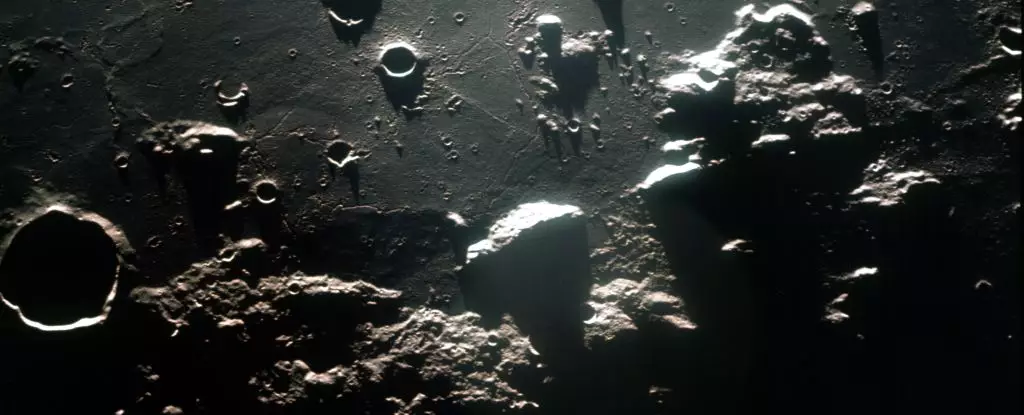The Moon has long been viewed as a barren, arid landmass, devoid of the essential resource that sustains life: water. However, recent breakthroughs in lunar mineralogy have painted a different picture. As scientists delve deeper into the Moon’s surface composition, their findings suggest that water, alongside its molecular cousin hydroxyl, is scattered across the lunar landscape in locations previously overlooked. This emerging knowledge not only reshapes our understanding of the Moon’s geological history but also holds significant implications for human exploration in the near future.
Much of the traditional lore around the Moon posits that water exists mainly in the form of ice trapped within the shadowed craters at the poles, where sunlight never penetrates. This belief limited expectations regarding potential water sources for future astronauts, confining their prospects primarily to extreme latitudinal zones. However, the analysis conducted by planetary scientist Roger Clark and colleagues challenges that notion. Their research reveals that water and hydroxyl could be found across various lunar terrains, including areas where the sun shines most fiercely. This suggests that our satellite, often thought lifeless, has the potential to harbor life-sustaining water, particularly in equatorial regions where human missions are likely to begin.
The discoveries stem from data acquired by the Moon Mineralogy Mapper (M3) aboard India’s Chandrayaan-1 mission, which orbited the Moon from 2008 to 2009. By capturing and analyzing the infrared light reflected from the lunar surface, scientists were able to discern the presence of water and hydroxyl based on their spectral signature. This innovative approach allowed researchers to not only identify the chemical composition of the Moon’s surface but also map specific locations rich in these essential molecules.
The spectrum analysis showed that despite the surface’s apparent barrenness, where no liquid water surges or pools, water molecules are intricately bound within the minerals making up the lunar soil. The implications are profound: if astronauts can locate these water-rich minerals, they could potentially extract water for hydration and other life-supporting purposes, thereby lessening the need to bring water from Earth.
Though water exists on the Moon, it is crucial to recognize that it is not static. Reports from the research indicate that water signatures on the lunar surface do not last indefinitely. Instead, they are gradually degraded by solar radiation and other environmental factors over millions of years. However, this loss mechanism leaves behind hydroxyl, a valuable molecule that can be utilized for human activities. Moreover, both cratering and volcanic activity can expose deeper, water-laden materials, providing future lunar explorers with opportunities to tap into hidden reservoirs of water that may be buried beneath the surface.
Interestingly, observations have shown that the water signature of specific igneous rocks, known as pyroxene, varies according to the sunlight’s angle. This variation once presented a mystery to scientists, sparking speculation that it might indicate water movement on the Moon. However, while it does suggest water interactions, the extent of mobility might be less than previously thought, highlighting the complex geology at play on our celestial neighbor.
The significance of these findings goes beyond scientific curiosity; they offer actionable insights for the future of lunar exploration. The knowledge that water and hydroxyl exist more widely across the lunar surface could fundamentally alter mission planning strategies for human voyages to the Moon. For instance, future astronauts could potentially harness hydroxyl-rich materials to extract water on-site, significantly alleviating the logistical challenges of transporting sufficient resources from Earth.
This newfound understanding also sparks interest in solving remaining lunar enigmas, such as the curious lunar swirls—striking patterns that traverse the surface with no clear explanation. Recent analyses suggest that these swirls are quite water-poor, indicating unique geological processes at work. Potential historical erosion processes may reveal what lies behind these formations, unraveling the Moon’s past.
The “dark horse” of water on the Moon is beginning to shed some light on a subject that has puzzled researchers for decades. As we further investigate the mysteries of the Moon’s surface, we not only enhance our understanding of its geological history but also pave the way for astronauts to thrive on this near neighbor. With complex lunar geology and water-rich materials waiting to be discovered, the Moon may soon be more than a celestial body; it could be a critical stepping stone for humanity’s next great leap into the cosmos.


Leave a Reply